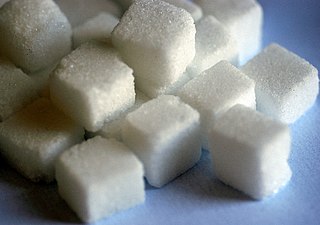Related Research Articles
Dieting is the practice of eating food in a regulated way to decrease, maintain, or increase body weight, or to prevent and treat diseases such as diabetes and obesity. As weight loss depends on calorie intake, different kinds of calorie-reduced diets, such as those emphasising particular macronutrients, have been shown to be no more effective than one another. As weight regain is common, diet success is best predicted by long-term adherence. Regardless, the outcome of a diet can vary widely depending on the individual.

Weight loss, in the context of medicine, health, or physical fitness, refers to a reduction of the total body mass, by a mean loss of fluid, body fat, or lean mass. Weight loss can either occur unintentionally because of malnourishment or an underlying disease, or from a conscious effort to improve an actual or perceived overweight or obese state. "Unexplained" weight loss that is not caused by reduction in calorific intake or increase in exercise is called cachexia and may be a symptom of a serious medical condition.
Basal metabolic rate (BMR) is the rate of energy expenditure per unit time by endothermic animals at rest. It is reported in energy units per unit time ranging from watt (joule/second) to ml O2/min or joule per hour per kg body mass J/(h·kg). Proper measurement requires a strict set of criteria to be met. These criteria include being in a physically and psychologically undisturbed state and being in a thermally neutral environment while in the post-absorptive state (i.e., not actively digesting food). In bradymetabolic animals, such as fish and reptiles, the equivalent term standard metabolic rate (SMR) applies. It follows the same criteria as BMR, but requires the documentation of the temperature at which the metabolic rate was measured. This makes BMR a variant of standard metabolic rate measurement that excludes the temperature data, a practice that has led to problems in defining "standard" rates of metabolism for many mammals.

Anaerobic exercise is a type of exercise that breaks down glucose in the body without using oxygen; anaerobic means "without oxygen". This type of exercise leads to a buildup of lactic acid. In practical terms, this means that anaerobic exercise is more intense, but shorter in duration than aerobic exercise.

Weight gain is an increase in body weight. This can involve an increase in muscle mass, fat deposits, excess fluids such as water or other factors. Weight gain can be a symptom of a serious medical condition.
Calorie restriction is a dietary regimen that reduces the energy intake from foods and beverages without incurring malnutrition. The possible effect of calorie restriction on body weight management, longevity, and aging-associated diseases has been an active area of research.
Hypermetabolism is defined as an elevated resting energy expenditure (REE) > 110% of predicted REE. Hypermetabolism is accompanied by a variety of internal and external symptoms, most notably extreme weight loss, and can also be a symptom in itself. This state of increased metabolic activity can signal underlying issues, especially hyperthyroidism. Patients with Fatal familial insomnia can also present with hypermetabolism; however, this universally fatal disorder is exceedingly rare, with only a few known cases worldwide. The drastic impact of the hypermetabolic state on patient nutritional requirements is often understated or overlooked as well.
Resting metabolic rate (RMR) is whole-body mammal metabolism during a time period of strict and steady resting conditions that are defined by a combination of assumptions of physiological homeostasis and biological equilibrium. RMR differs from basal metabolic rate (BMR) because BMR measurements must meet total physiological equilibrium whereas RMR conditions of measurement can be altered and defined by the contextual limitations. Therefore, BMR is measured in the elusive "perfect" steady state, whereas RMR measurement is more accessible and thus, represents most, if not all measurements or estimates of daily energy expenditure.
Specific dynamic action (SDA), also known as thermic effect of food (TEF) or dietary induced thermogenesis (DIT), is the amount of energy expenditure above the basal metabolic rate due to the cost of processing food for use and storage. Heat production by brown adipose tissue which is activated after consumption of a meal is an additional component of dietary induced thermogenesis. The thermic effect of food is one of the components of metabolism along with resting metabolic rate and the exercise component. A commonly used estimate of the thermic effect of food is about 10% of one's caloric intake, though the effect varies substantially for different food components. For example, dietary fat is very easy to process and has very little thermic effect, while protein is hard to process and has a much larger thermic effect.

In human nutrition, empty calories are those calories found in foods and beverages composed primarily or solely of calorie-rich macronutrients such as sugars and fats, but little or no micronutrients, fibre, or protein. Foods composed mostly of empty calories have low nutrient density, meaning few other nutrients relative to their energy content. Empty calories are more difficult to fit into a diet that is both balanced and within TDEE, and so readily create an unhealthy diet.

An underweight person is a person whose body weight is considered too low to be healthy. A person who is underweight is malnourished.
General fitness training works towards broad goals of overall health and well-being, rather than narrow goals of sport competition, larger muscles or concerns over appearance. A regular moderate workout regimen and healthy diet can improve general appearance markers of good health such as muscle tone, healthy skin, hair and nails, while preventing age or lifestyle-related reductions in health and the series of heart and organ failures that accompany inactivity and poor diet.
Starvation response in animals is a set of adaptive biochemical and physiological changes, triggered by lack of food or extreme weight loss, in which the body seeks to conserve energy by reducing metabolic rate and/or non-resting energy expenditure to prolong survival and preserve body fat and lean mass.
The Harris–Benedict equation is a method used to estimate an individual's basal metabolic rate (BMR).
In biology, energy homeostasis, or the homeostatic control of energy balance, is a biological process that involves the coordinated homeostatic regulation of food intake and energy expenditure. The human brain, particularly the hypothalamus, plays a central role in regulating energy homeostasis and generating the sense of hunger by integrating a number of biochemical signals that transmit information about energy balance. Fifty percent of the energy from glucose metabolism is immediately converted to heat.

Weight management comprises behaviors, techniques, and physiological processes that contribute to a person's ability to attain and maintain a healthy weight. Most weight management techniques encompass long-term lifestyle strategies that promote healthy eating and daily physical activity. Weight management generally includes tracking weight over time and identifying an individual's ideal body weight.
Sleep and weight is the association between the amount of sleep an individual obtains and the weight of that individual.
The benefits of physical activity range widely. Most types of physical activity improve health and well-being.
Energy expenditure, often estimated as the total daily energy expenditure (TDEE), is the amount of energy burned by the human body.
Non-exercise activity thermogenesis (NEAT), also known as non-exercise physical activity (NEPA), is energy expenditure during activities that are not part of a structured exercise program. NEAT includes physical activity at the workplace, hobbies, standing instead of sitting, walking around, climbing stairs, doing chores, and fidgeting. Besides differences in body composition, it represents most of the variation in energy expenditure across individuals and populations, accounting from 6-10 percent to as much as 50 percent of energy expenditure in highly active individuals.
References
- ↑ "Counting calories: Get back to weight-loss basics". Mayo Clinic. Retrieved 12 January 2019.
- 1 2 Redman, LM; Heilbronn, LK; Martin, CK; de Jonge, L; Williamson, DA; Delany, JP; Ravussin, E (February 9, 2009). "Metabolic and Behavioral Compensations in Response to Caloric Restriction: Implications for the Maintenance of Weight Loss". PLOS ONE. 4 (2): e4377. Bibcode:2009PLoSO...4.4377R. doi: 10.1371/journal.pone.0004377 . PMC 2634841 . PMID 19198647.
- ↑ "Nutrition for Injury Recovery: Part 3". Precision Nutrition. 2013-06-21. Retrieved 2020-12-16.
- ↑ "CALORIC NEEDS". www.utmb.edu. Archived from the original on 31 May 2016. Retrieved 2015-07-09.
- ↑ Dulloo, A. G.; Geissler, C. A.; Horton, T.; Collins, A.; Miller, D. S. (1989-01-01). "Normal caffeine consumption: influence on thermogenesis and daily energy expenditure in lean and postobese human volunteers". The American Journal of Clinical Nutrition. 49 (1): 44–50. doi:10.1093/ajcn/49.1.44. ISSN 0002-9165. PMID 2912010.
- ↑ Schrader, Patrick; Panek, Leah M.; Temple, Jennifer L. (2013). "Acute and chronic caffeine administration increases physical activity in sedentary adults". Nutrition Research. 33 (6). Elsevier BV: 457–463. doi:10.1016/j.nutres.2013.04.003. ISSN 0271-5317. PMID 23746561.
- 1 2 "Dietary Supplements for Weight Loss — Health Professional Fact Sheet". ods.od.nih.gov. Retrieved 2015-07-09.
- ↑ Lu, Yuan-qiang; Jiang, Jiu-kun; Huang, Wei-dong (March 2011). "Clinical features and treatment in patients with acute 2,4-dinitrophenol poisoning". Journal of Zhejiang University Science B. 12 (3): 189–192. doi:10.1631/jzus.B1000265. ISSN 1673-1581. PMC 3048933 . PMID 21370503.
- ↑ Joslin, Elliott Proctor; Kahn, C. Ronald (2005-01-01). Joslin's Diabetes Mellitus: Edited by C. Ronald Kahn ... [et Al.]. Lippincott Williams & Wilkins. ISBN 9780781727969.
- ↑ Shah, Khushali (April 4, 2021). "The Ultimate Calorie Deficit Guide For Weight Loss - Healthy And Khush". healthyandkhush.com. Retrieved December 30, 2022.
- ↑ Hrasekvlusku.cz (6 June 2023). "Kalorický deficit: Klíč k úspěšnému hubnutí – vše, co musíte vědět".
- ↑ "How to Calculate Calorie" . Retrieved 15 January 2025.